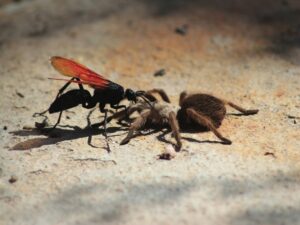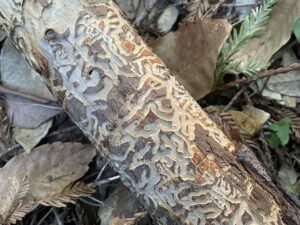Go for a walk in the woods in winter, and things can seem pretty quiet. There’s not much going on that you can see, but then a log beside the trail catches your eye. You tilt it up to see what might be lurking underneath: There’s a flash of orange as a centipede scurries beneath a rotting leaf, and two shiny black beetles dash off into the grass. A small, smooth wormlike thing with big black eyes and tiny legs sits motionless until you reach down to touch it gently: The second you do, it flops around violently, then freezes. It’s a slender salamander. Those tiny legs are useless for running, so that flopping around was its best effort to get away from a terrifying predator–you!
There’s a world of critters under woodland rocks and logs, especially in winter, and most of them are doing their best to make a living while hiding from big predators, whether hungry crows or curious kids.
Though you rarely see them, slender salamanders are probably the Bay Area’s most numerous terrestrial vertebrate (land-dwelling animal with a backbone). In winter, these salamanders (and many other animals that live underground during the dry season) come to the surface to feast on insects and other invertebrates. Slender salamanders hide under logs or other objects to stay wet and cool, but at night and when it rains, these amphibians come out to hunt.
Look at the area just below a big mushroom on a wet day–you just might see several slender salamanders there, waiting to eat the insects attracted by the mushrooms. After the rains stop and the surface dries out, the salamanders go back underground; their long skinny bodies allow them to squeeze into the smallest crevices where it stays cool and moist even during the summer drought. Slender salamanders can live many years, migrating to the surface and back underground as the seasons change. This means you could find the same salamanders under the same objects every year. So it’s very important to leave these animals exactly where you find them; this is the only home they know.
Some of the creatures you find in places like this are simply hiding from predators until nightfall, when they become active. Jerusalem crickets, for example, are often found under wood or rocks, but we know they come out at night because their distinctive heads and legs are often found in owl pellets (indigestible stuff, like bones and hair, coughed up by owls). Other hide-by-day, hunt-by-night insects often found under logs are the snail-eating beetles, which have long narrow thoraxes and heads that allow them to reach deep into snail shells.
Even some reptiles can be discovered under logs during the wet season. The sharp-tailed snake is one of few snakes in our area that is active during mid-winter. Its favorite food is slugs, which also come out to feed at night. In late winter and early spring, ring-necked snakes also hide under logs and rocks. Here they lie in wait for their favorite foods, like slender salamanders and sharp-tailed snakes!
If you turn over logs or rocks, remember to carefully put them back exactly where you found them. The space beneath these objects might look like lifeless dirt, but it’s a special home for an amazing variety of living things.
Get Out!
Finding critters under wood and stones is easy. Look under potted plants (and other things sitting on the ground outside) around your house, where you’ll find all kinds of new friends, even in the city. For a more organized critter search, check out David Herlocker’s regular family walks in Marin [free, marinopenspace.org, (415)499-6387]. You’ll find (and release) many fascinating animals and learn to treat them and their habitat with respect.
In the East Bay, head to Tilden Regional Park for a Life Under Logs program on January 17 [ages 5-12, free, 2-3:30 p.m., ebparks.org, (510)544-2233]. Farther east, Sunol Regional Park naturalist Cat Taylor has a bevy of events for log-lovers: Search for salamanders on February 4, an outing that’s part of the Outdoor Discoveries series [ages 3-5, $6 per child, 10-11:30 a.m., reservations required, ebparks.org, (510)544-3240]. Or head out on a Love in the Wilderness hike on February 13, in search of mating newts [ages 7 and up, free, 1-4:30 p.m., call to confirm, (510)544-3240].
In the Santa Cruz Mountains, join a newt roundup at Sanborn County Park on March 20 [9-11 a.m.; $10/adult, $5/child, $25/family; ysi-ca.org, (408)356-4945]. [Dan Rademacher]

.jpg)



